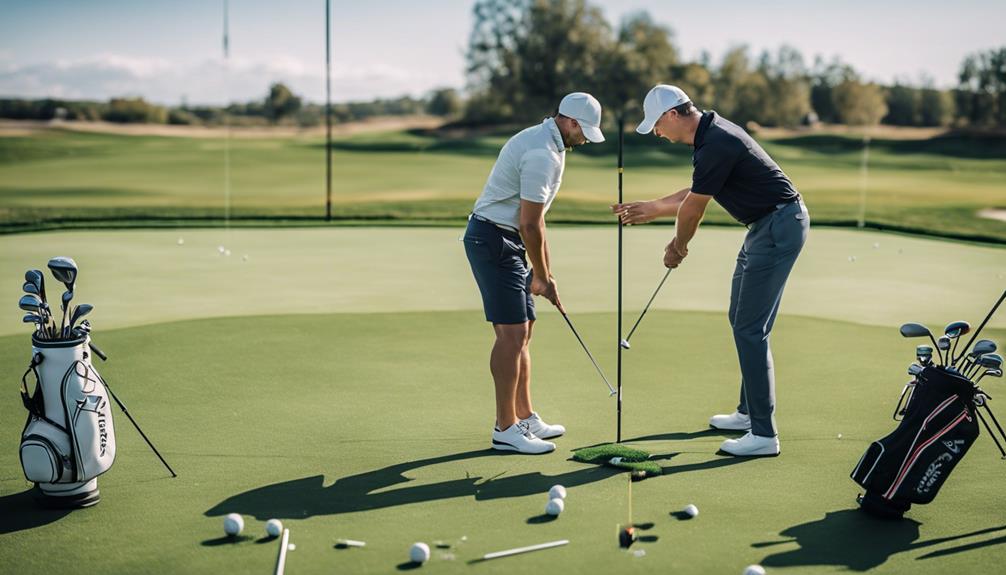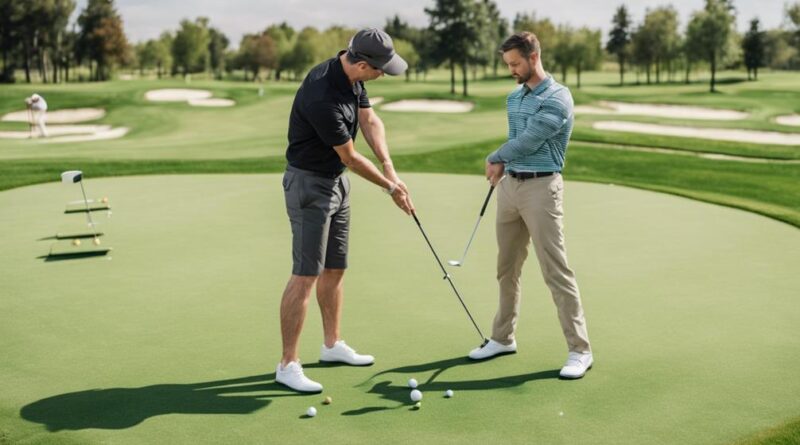Top 7 Golf Coaching Techniques for Newbies
Have you ever wondered what sets apart a beginner from a golfer who confidently navigates the course?
Mastering the basics is key, but diving deeper into golf coaching techniques can elevate your game to new heights.
From perfecting your grip and stance to honing your mental fortitude, these top 7 techniques are essential for any newbie looking to make significant strides on the green.
So, are you ready to unlock the secrets that can transform your golfing experience?
Grip and Stance Essentials
To improve your golf game, mastering the proper grip and stance is essential. Proper alignment and balance techniques are key components to ensure a solid foundation for your swing. When it comes to the grip, make sure your hands work together as a single unit. Your leading hand (the top hand) should grip the club in a way that the 'V' formed by your thumb and index finger points towards your trailing shoulder. The trailing hand should then cover the thumb of the leading hand with a comfortable grip pressure, ensuring both hands work in unison throughout the swing.
In addition to the grip, your stance plays a crucial role in your overall performance. Proper alignment starts with your feet shoulder-width apart and the ball positioned in line with the instep of your leading foot. Your body should be slightly tilted forward from the hips, allowing for a natural spine angle. Maintaining balance throughout your stance is vital. Distribute your weight evenly between both feet, feeling grounded and stable. Avoid leaning too far back or forward, as this can affect your swing and accuracy.
Swinging Fundamentals
How can you master the swinging fundamentals for a powerful and precise golf game? Two key elements to focus on are proper posture and club alignment. Ensuring you have the correct setup will greatly impact the quality of your swing.
Proper posture is essential for a successful golf swing. Stand with your feet shoulder-width apart, knees slightly flexed, and your back straight. Bend forward from your hips, not your waist, and let your arms hang naturally. This posture provides a stable base for your swing and allows for better rotation through the shot.
Club alignment is crucial for hitting accurate shots. Before swinging, ensure that the clubface is square to the target. Align your body parallel to the target line, with your feet, hips, and shoulders all pointing in the same direction. This alignment helps promote a straight swing path and minimizes the chances of slicing or hooking the ball.
Short Game Techniques
Mastering the finesse of short game techniques in golf requires precision and focus on crucial elements like chipping and putting. When it comes to chipping accuracy, it's essential to choose the right club based on the distance to the pin and the trajectory needed. Practice different chipping techniques to develop a feel for how far the ball will roll after landing. Focus on maintaining a steady stance and a smooth tempo to ensure consistent and accurate chip shots.
Bunker shots can be intimidating for many new golfers, but with the right technique, you can tackle them effectively. When faced with a bunker shot, open your stance and clubface to increase loft and help the ball get out of the sand. Aim to hit the sand a few inches behind the ball to splash it onto the green. Practice bunker shots regularly to build confidence and improve your consistency.
Putting Tips for Accuracy
For better accuracy in putting, focus on your alignment and grip. Proper alignment adjustments are crucial in ensuring that your putts stay on target. When setting up for a putt, make sure your feet, hips, and shoulders are parallel to the target line. Align the putter face square to your target, which helps in achieving a more accurate putt. Additionally, maintain a light grip pressure to allow for a smoother stroke and better feel of the putter head.
Distance control is another key aspect of putting accuracy. To improve your distance control, spend time practicing different length putts to develop a sense of how far back you need to take the putter for varying distances. A consistent putting stroke with controlled speed is essential for achieving accuracy in your putts. Focus on hitting the ball with the center of the putter face to ensure a more consistent roll and distance control.
Understanding Course Management
To navigate a golf course effectively, strategize your shots based on the layout and hazards present. Strategic planning and thoughtful shot selection are key elements in mastering course management. Here are three crucial tips to help you improve your strategic approach on the golf course:
- Assess the Layout: Before teeing off, take a moment to study the layout of the hole. Identify potential hazards such as bunkers, water bodies, or out-of-bounds areas. This assessment will allow you to plan your shots more effectively, avoiding risky areas and positioning yourself for better approaches to the green.
- Play to Your Strengths: Consider your strengths and weaknesses as a golfer when planning your shots. If you have a reliable long iron but struggle with your short game, adjust your strategy to capitalize on your strengths. By playing to your strengths, you can set yourself up for success on each hole.
- Think One Shot Ahead: As you navigate the course, always think one shot ahead. Consider how your current shot will impact your next one. By thinking ahead and planning your shots strategically, you can avoid risky situations and set yourself up for more manageable approaches to the green. Strategic planning and smart shot selection are essential skills in mastering course management.
Mental Game Strategies
Utilize effective mental game strategies to enhance your focus and performance on the golf course. Visualization exercises can be a powerful tool to improve your game. Before each shot, take a moment to visualize the perfect swing and the ball landing exactly where you want it to. This mental imagery can help you feel more confident and prepared when you step up to the ball. Confidence building is also crucial in golf. Remind yourself of your past successes and focus on your strengths rather than dwelling on mistakes.
In addition to visualization exercises, incorporating relaxation techniques can help calm your nerves and improve your performance. Deep breathing exercises or progressive muscle relaxation can help you stay composed under pressure. Furthermore, focus training is essential for maintaining concentration throughout your game. Practice mindfulness techniques to keep your mind from wandering and stay in the present moment.
Practice Drills for Improvement

Enhance your golf skills by incorporating practice drills for improvement, focusing on refining your technique and consistency on the course. To elevate your game, consider the following key practice drills:
- Target Alignment: One crucial aspect of golf is aligning your shots properly. To practice this, set up on the driving range with alignment rods or clubs on the ground to guide your stance. Aim at specific targets and pay attention to how your body lines up with them. Consistent practice will improve your ability to align your shots accurately on the course.
- Swing Tempo: Maintaining a smooth and consistent swing tempo is essential for good ball striking. To work on this, practice swinging at different speeds while maintaining control and balance. Start with a slow backswing, then accelerate smoothly through the ball, focusing on a fluid motion. Use a metronome or count in your head to establish a rhythm that works for you. By honing your swing tempo, you'll develop better timing and distance control.
- Short Game Challenges: A significant part of scoring well in golf is having a strong short game. Create practice drills that focus on chipping, pitching, and putting. Set up targets at varying distances and practice different types of shots to improve your feel and touch around the greens. Consistent short game practice will lower your scores and boost your overall game performance.
Finding the Right Golf Coach
When seeking a suitable golf coach, carefully evaluate their experience, teaching style, and compatibility with your learning preferences. Coach evaluation is crucial in finding the right fit for your golf journey. Look for a coach with a solid background in golf, preferably one who's experience working with players of varying skill levels. A coach who's been involved in the sport for a significant amount of time will likely have a wealth of knowledge to share with you.
Consider your learning styles when choosing a golf coach. Some coaches may focus more on technical aspects, while others may emphasize the mental game or physical conditioning. Reflect on how you learn best – whether you prefer visual demonstrations, verbal explanations, or hands-on practice. Finding a coach whose teaching style aligns with your preferred learning methods can greatly enhance your overall experience and progress on the course.
Compatibility with your learning preferences is key to a successful coaching relationship. Communication is vital in golf instruction, so ensure that you and your coach can effectively convey ideas and feedback to each other. A good coach shouldn't only provide valuable guidance but also motivate and inspire you to improve. By carefully considering these factors, you can find the right golf coach to help you reach your full potential on the course.
Frequently Asked Questions
How Can I Prevent Myself From Getting Nervous on the Golf Course?
To prevent yourself from getting nervous on the golf course, try incorporating breathing exercises and visualization techniques. Take deep breaths to calm your nerves and visualize successful shots to boost your confidence.
Engage in positive self-talk to stay relaxed and focused. By using these relaxation techniques, you can help manage your nerves and improve your performance on the golf course.
What Should I Do if I Can't Seem to Improve My Accuracy With My Putting?
If you can't seem to improve your accuracy with putting, focus on two key areas.
First, check your putting alignment to ensure your body and club face are aligned correctly with the target.
Next, consider making a grip adjustment to find a comfortable and effective grip that works for you.
Are There Any Specific Drills That Can Help Me Improve My Golf Swing Speed?
To improve your golf swing speed, focus on strength training for more power and flexibility exercises for better range of motion.
Work on your swing tempo to maximize your speed potential.
Additionally, consider club selection to match your swing speed.
How Do I Handle the Mental Pressure of Playing in a Tournament?
When playing in a tournament, handling mental pressure is key. Use visualization techniques to imagine success. Practice breathing exercises to stay calm.
Engage in positive self-talk to boost confidence. Implement relaxation techniques to ease nerves. Remember to focus on one shot at a time and trust your skills.
Stay present, breathe, and believe in yourself to perform your best under pressure.
What Should I Look for in a Golf Coach to Ensure They Are the Right Fit for Me?
When selecting a golf coach, focus on coach compatibility and training styles to ensure the right fit. Look for strong communication skills and high patience levels.
A coach who understands your learning style and can effectively communicate instructions will enhance your progress. Patience is crucial as you navigate the challenges of learning golf.
Find a coach who aligns with your needs and supports your growth in the sport.
Conclusion
So there you have it, newbies! By mastering these top 7 golf coaching techniques, you'll be well on your way to improving your game and enjoying the sport even more.
Remember to focus on your grip and stance, swinging fundamentals, short game techniques, putting accuracy, course management, mental game strategies, and practice drills.
And don't forget to find the right golf coach to guide you along the way. Keep practicing and have fun out on the course!
